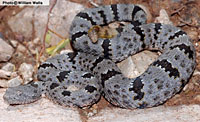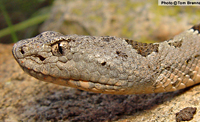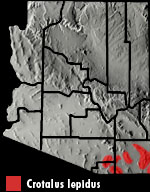Online Field Guide to The Reptiles and Amphibians of Arizona


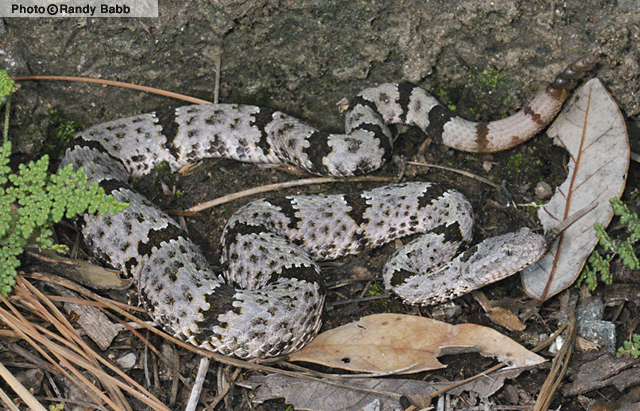
Cochise County, AZ
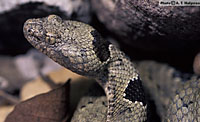 Cochise Co., AZ |
||
 Cochise Co., AZ |
| ROCK RATTLESNAKE Crotalus lepidus |
Venomous
|
| DESCRIPTION: A small (up to 840 mm or 33″ in total length excluding rattle) light greenish-gray to blue-gray rattlesnake with 14 to 24 dark gray-brown to black, jagged crossbands on the back. Arizona specimens often have dark spots or flecks between the dark bands. In adult males an almost iridescent green stripe is often visible running the length of the back. Pink or salmon mottling is sometimes present on the lower sides. The underside is pinkish and becomes darker toward the tail. The tail is bright yellow in juvenile animals and salmon or peach in adults. The pupils are vertically elliptical and the dorsal scales are keeled. The neck is slender and the head is broad and triangular. On the end of the tail is a rattle composed of a series of loosely interlocking keratinous sections. A new section is added each time the snake sheds its skin. The rattle is large relative to the size of the body.
DISTRIBUTION: This snake inhabits many of the “sky island” ranges of southeastern Arizona including the Chiricahua, Peloncillo, Dragoon, Whetstone, Santa Rita, Huachucas, and Canelos. It is found at elevations ranging from about 4,000′ to 8,500′. HABITAT: Most of this snake’s range in Arizona is within the Madrean Evergreen Woodland and Petran Montane Conifer Forest communities but, in some areas, it follows drainages down into grassland communities. As its common name implies the Banded Rock Rattlesnake frequents rocky terrain. Large rock outcroppings, rocky stream beds, and steep talus slopes are all favored haunts for this snake. DIET: The Rock Rattlesnake eats centipedes, lizards, small rodents, and birds. It uses venom injected through long, hollow, retractable fangs to kill and begin digesting its prey. REPRODUCTION: Mating takes place in summer. A litter of up to 10 young is born in summer. REMARKS: This rattlesnake is capable of delivering potent venom. If encountered it should be left alone. A large percentage of envenomations occur when a snake is handled or abused. This snake is protected in Arizona. It is against Arizona state law to harass, harm, pursue, hunt, shoot, wound, kill, trap, capture, or collect this animal or to attempt to engage in any such conduct.By Thomas C. Brennan Bartlett. 2000. Snakes of North America: Western Region. Gulf Publishing Co. Houston, TX Brennan, T. C., & A. T. Holycross. 2006. A Field Guide to Amphibians and Reptiles in Arizona. Arizona Game and Fish Department. Phoenix, AZ Degenhardt, W. G., Painter, C. W., and Price, A. H.. 1996. Amphibians and Reptiles of New Mexico. University of New Mexico Press. Albuquerque. Fowlie. 1965. The Snakes of Arizona. Azul Quinta Press, Fallbrook, California Lowe, Schwalbe, Johnson. 1986. The Venomous Reptiles of Arizona. Nongame Branch Stebbins. 1985. Western Reptiles and Amphibians. Houghton Mifflin. New York, NY |
|
Visit Partners in Amphibian and Reptile Conservation:


HOME
Copyright © 2023, Arizona Game and Fish Department. All rights reserved.
If you make use of the textual contents of this site in reports, publications, etc. please cite and credit the author(s) and photographer(s). All photos on this website are copyrighted. However, those found in the species account section may be used for any noncommercial scientific, educational, or conservation purposes provided that photographs are not altered and continue to bear the copyright symbol and name of the photographer. Please contact the photographer regarding commercial use of copyrighted photographs.










